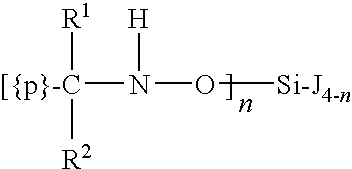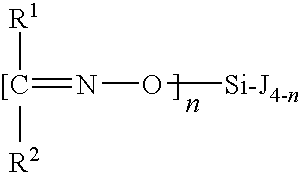Silane coupled polymers
a coupled polymer and silane technology, applied in the field of silane coupled polymers, can solve the problems difficult drying of low molecular weight polymers, and difficult processing of high compound mooney viscosity
- Summary
- Abstract
- Description
- Claims
- Application Information
AI Technical Summary
Problems solved by technology
Method used
Image
Examples
examples
[0072]In the examples, dried glass vessels previously sealed with extracted septum liners and perforated crown caps under a positive N2 purge were used for all preparations. Butadiene (22.2% in hexane), styrene (33% in hexane), hexane, n-butyllithium (1.60 M in hexane), 2,2-bis(2′-tetrahydrofuryl)propane solution (1.6 M solution in hexane, stored over CaH2), and butylated hydroxytoluene (BHT) solution in hexane were used.
[0073]Commercially available reagents and starting materials included the following (with as-purchased purities given in parentheses), all of which were acquired from Sigma-Aldrich Co. (St. Louis, Mo.) and used without further purification unless otherwise noted in a specific example: tetraethyl orthosilicate (99%), SnCl4 (99%), and SiCl4. Methyltris-(methylethylketoximino)silane (95% purity) and tetrakis(methylethylketoximino)silane were acquired from Gelest Inc. (Morrisville, Pa.) and dried over molecular sieves (0.3 nm).
[0074]Testing data in the Examples was perf...
examples 1-6
[0076]To a reactor equipped with turbine agitator blades were added 3.03 kg hexane, 1.20 kg styrene solution, and 7.06 kg butadiene solution. The reactor was charged with 8.27 mL n-butyllithium, followed by 4.07 mL of 2,2-bis(2′-tetrahydrofuryl)propane solution. The batch temperature was controlled at ˜49° C. After about an hour, the reaction mixture was cooled to ˜32° C.
[0077]Portions of the polymer cement (˜400 g each) were transferred from the reactor to sealed, N2-purged 800 mL glass vessels. One sample was terminated with isopropanol, coagulated in isopropanol containing BHT and drum dried. This polymer had a Mn of 132 kg / mol, a molecular weight distribution of 1.03, and a glass transition temperature of −32.0° C. The styrene content of the polymer was ˜22%, and its 1,2-microstructure (i.e., vinyl content) was ˜55% (relative to total butadiene content).
[0078]The remaining samples were reacted (50° C. bath, rotated for ˜60 minutes) with, respectively,
[0079]1:5 tetrakis(methyleth...
examples 7-12
[0086]To a reactor equipped with turbine agitator blades was added 4.5 kg hexane, 1.8 kg styrene solution, and 5.0 kg butadiene solution. The reactor was charged with 7.1 mL n-butyllithium, followed by 0.79 mL potassium t-amylate and 0.43 mL of 2,2-bis(2′-tetrahydrofuryl)propane solution. The batch temperature was controlled at ˜82° C. After about an hour, the reaction mixture was cooled to ˜32° C.
[0087]Portions of the polymer cement (˜400 g each) were transferred from the reactor to sealed, N2-purged 800 mL glass vessels. One sample was terminated with isopropanol, coagulated in isopropanol containing BHT and drum dried. This polymer had a Mn of 145 kg / mol, a molecular weight distribution of 1.06, and a glass transition temperature of −44° C. The styrene content of the polymer was ˜38%, and its 1,2-microstructure (i.e., vinyl content) was ˜22% (relative to total butadiene content).
[0088]The remaining samples were terminated (50° C. bath, rotated for 60 minutes) with, respectively,
[...
PUM
| Property | Measurement | Unit |
|---|---|---|
| resistance to abrasion | aaaaa | aaaaa |
| rolling resistance | aaaaa | aaaaa |
| physical properties | aaaaa | aaaaa |
Abstract
Description
Claims
Application Information
 Login to View More
Login to View More - R&D
- Intellectual Property
- Life Sciences
- Materials
- Tech Scout
- Unparalleled Data Quality
- Higher Quality Content
- 60% Fewer Hallucinations
Browse by: Latest US Patents, China's latest patents, Technical Efficacy Thesaurus, Application Domain, Technology Topic, Popular Technical Reports.
© 2025 PatSnap. All rights reserved.Legal|Privacy policy|Modern Slavery Act Transparency Statement|Sitemap|About US| Contact US: help@patsnap.com



